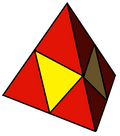Examples
| Name Conway name | Image | Vertex configurations | V | E | F | F3 | F4 | F5 | F6 | F8 | F10 | F12 | Symmetry |
|---|---|---|---|---|---|---|---|---|---|---|---|---|---|
| Associahedron t4dP3 | 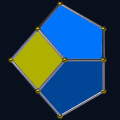 | 2 (5.5.5) 12 (4.5.5) | 14 | 21 | 9 | 3 | 6 | Dih3 order 12 | |||||
| Truncated triakis tetrahedron t6kT |  | 4 (5.5.5) 24 (5.5.6) | 28 | 42 | 16 | 12 | 4 | Td, [3,3] order 24 | |||||
| Pentahexagonal pyritoheptacontatetrahedron |  | 12 (3.5.3.6) 24 (3.3.5.6) 24 (3.3.3.3.5) | 60 | 132 | 74 | 56 | 12 | 6 | Th, [3+,4] order 24 | ||||
| Chamfered cube cC |  | 24 (4.6.6) 8 (6.6.6) | 32 | 48 | 18 | 6 | 12 | Oh, [4,3] order 48 | |||||
| -- |  | 12 (5.5.6) 6 (3.5.3.5) 12 (3.3.5.5) | 30 | 54 | 26 | 12 | 12 | 2 | D6h, [6,2] order 24 | ||||
| -- |  | 6 (5.5.5) 9 (3.5.3.5) 12 (3.3.5.5) | 27 | 51 | 26 | 14 | 12 | D3h, [3,2] order 12 | |||||
| Tetrated dodecahedron | 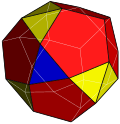 | 4 (5.5.5) 12 (3.5.3.5) 12 (3.3.5.5) | 28 | 54 | 28 | 16 | 12 | Td, [3,3] order 24 | |||||
| Chamfered dodecahedron cD | 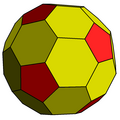 | 60 (5.6.6) 20 (6.6.6) | 80 | 120 | 42 | 12 | 30 | Ih, [5,3] order 120 | |||||
| Rectified truncated icosahedron atI |  | 60 (3.5.3.6) 30 (3.6.3.6) | 90 | 180 | 92 | 60 | 12 | 20 | Ih, [5,3] order 120 | ||||
| Truncated truncated icosahedron ttI | 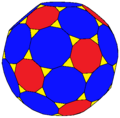 | 120 (3.10.12) 60 (3.12.12) | 180 | 270 | 92 | 60 | 12 | 20 | Ih, [5,3] order 120 | ||||
| Expanded truncated icosahedron etI |  | 60 (3.4.5.4) 120 (3.4.6.4) | 180 | 360 | 182 | 60 | 90 | 12 | 20 | Ih, [5,3] order 120 | |||
| Snub rectified truncated icosahedron stI |  | 60 (3.3.3.3.5) 120 (3.3.3.3.6) | 180 | 450 | 272 | 240 | 12 | 20 | I, [5,3]+ order 60 |







